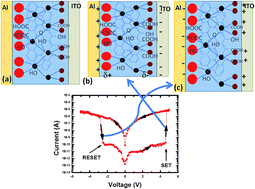Electroforming free high resistance resistive switching of graphene oxide modified polar-PVDF
Abstract
Future nanoelectronics for nonvolatile memory elements require novel materials and devices that can switch logic states with a low power consumption, minimum heat dissipation, high-circuit density, fast switching speed, large endurance and long charge retention period. Herein, we report novel high resistance resistive switching in a polar beta-polyvinylidene fluoride (β-PVDF) and graphene oxide (GO) composite. A high resistance switching ratio was achieved without the realization of the essential current-filament forming condition mainly responsible for switching the device from high to low resistance states. β-PVDF is a well known ferroelectric/piezoelectric material which changes shape and size after application of an external electric field. We propose a model which describes how the present β-PVDF–GO composite changes shape after application of an external electric field (E) which provides a favorable environment for the formation of the current linkage path of GO in the PVDF matrix. The applied positive SET electric fields (+E) switch the composite from a high to a low resistance state, which further re-switches from a low to a high resistance state under negative RE-SET electric fields (−E). The positive and negative E-fields are responsible for the contraction and expansion of β-PVDF, respectively, redox reactions between GO and adsorbed water, oxygen migrations, and/or metal diffusion from the electrode to the β-PVDF–GO matrix. The above mentioned characteristics of the composite allows switching from one high resistance state to another high resistance state. The switching current lies below the range of 10–100 μA with an exceptionally high switching ratio, which meets one of the pre-requisite criteria of low power nanoelectronics memristors.


 Please wait while we load your content...
Please wait while we load your content...